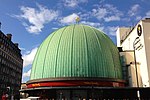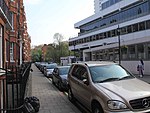Madame Tussauds
All lists having no precise inclusion criteriaAll pages needing cleanupAmusement museumsLists having no precise inclusion criteria from May 2022Madame Tussauds ... and 4 more
Media museumsMerlin Entertainments GroupUse British English from January 2012Wax museums

Madame Tussauds (UK: , US: ) is a wax museum in London; it has smaller museums in other major cities. It was founded by wax sculptor Marie Tussaud in 1835. It used to be spelled as "Madame Tussaud's"; the apostrophe is no longer used. Madame Tussauds is a major tourist attraction in London, displaying the waxworks of famous and historical figures, as well as popular film and television characters. The nearest station to the museum is Baker Street which is at the walking distance of 120 metres (390 ft).
Excerpt from the Wikipedia article Madame Tussauds (License: CC BY-SA 3.0, Authors, Images).Madame Tussauds
Marylebone Road, City of Westminster Marylebone
Geographical coordinates (GPS) Address Website External links Nearby Places Show on map
Geographical coordinates (GPS)
| Latitude | Longitude |
|---|---|
| N 51.522777777778 ° | E -0.15527777777778 ° |
Address
Madame Tussauds
Marylebone Road
NW1 5JR City of Westminster, Marylebone
England, United Kingdom
Open on Google Maps










